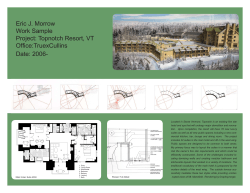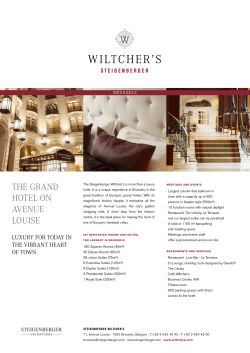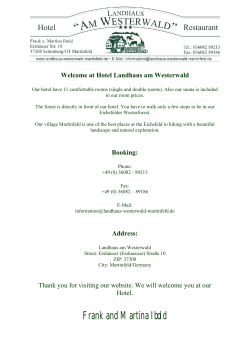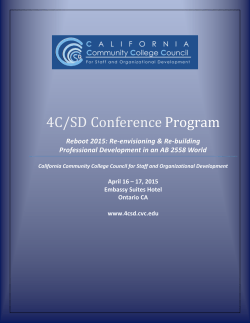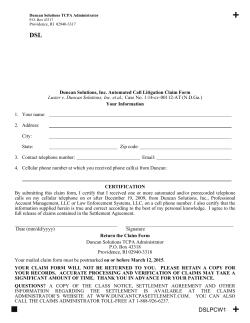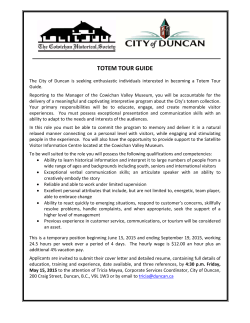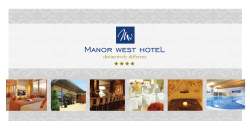
Get into the extended-stay game, sources say
Link to Article Get into the extended-stay game, sources say April 8 2015 The U.S. extended-stay segment has seen growth in key metrics of late, and that progression shouldn’t slow anytime soon, panelists speaking during the Hunter Hotel Conference said. Bill Duncan of Hilton Worldwide Holdings (right) speaks during a Hunter Hotel Conference breakout session about the extended-stay segment, while Chris Rutherford of Affordable Suites of America (left) looks on. (Photo: Alicia Hoisington) By Alicia Hoisington Managing Editor ahoisington@hotelnewsnow.com ATLANTA—Panelists speaking during the 27th annual Hunter Hotel Conference said that the extendedstay space of the hotel industry is the place to be. “It’s a fascinating segment,” said Bill Duncan, global head of extended-stay brand management at Hilton Worldwide Holdings, during the “What’s happening in the world of extended stay?” breakout session. “You get to make a lot of money and get to know your customers.” Speakers pointed to growth in revenue per available room, average daily rate, demand and rooms revenue for the segment at their respective companies. “You’re seeing all this great growth in (average daily rate) and (revenue per available room). At some point inflation will come into play, then you can raise your rates even more. Inflation will extend the cycle even longer,” said Robert O’Leary, regional VP of franchise development for Value Place. Mark Skinner, partner at The Highland Group, said the segment should see further RevPAR growth of 7% to 9% this year in the United States. “You need to get into the extended-stay game,” Duncan said. “There’s a significant amount of momentum. It’s a highly opportunistic and fun segment.” Why extended stay? One reason to dive into the extended-stay market is because there is more demand than supply out there, according to O’Leary. “So if you’re in the right location and choose the right place to build, you can feel pretty good that you’ll be successful in that location,” he said. In addition, he said the expense structure is lower for an extended-stay hotel. For instance, rooms do not need to be cleaned every day, which cuts down on labor and operating costs. “You have the ability to combine the DNA of an apartment with the DNA of a hotel,” O’Leary said. “If you do it correctly in the right location, it becomes the best of both worlds. It’s a good model. As people get into extended stay, you’ll see usually once they build the first extended stay it’s very likely they will pursue more opportunities in that space.” Duncan said from an owner or developer perspective, extended stay is a good addition to create a more balanced portfolio. He said that during the last downturn, Hilton’s extended-stay brands Homewood Suites and Home2 Suites were the last to go into the downturn and were the first to come out strong. “Having extended stay really makes a significant difference, and that’s when we saw a significant rise in interest and new franchisees coming into Homewood and Home2, because of all those great things coming together and allowing you to normalize your portfolio,” he said. “We don’t talk to people that have a big, balanced portfolio. We really look at people that are developers who care about bottom-line profitability, period,” said Chris Rutherford, COO of Affordable Suites of America. “They don’t have to have a name necessarily beside their pillow at night so they sleep well, but they do want a pile of money beside them.” His company has cut the model down, finding its own niche to operate in, he said. Rooms in the model are about 500 square feet, and hotels have 49 rooms. “We can kind of handle these downturns, and inevitability we’re going to face one,” Rutherford said. Skinner said the essence of the model is appealing to guests. For example, he works with a traveling youth sports team that always opts for extended stay due to features such as two-room suites and the in-room kitchenette that allows guests to bring in their own food. “It’s a value buy,” he said. Build it and they will come Looking for those demand generators can help determine where to develop an extended-stay product. Rutherford said to look to university locations for possible places to develop. Areas with hospitals are good locations, too, due to potential guests such as traveling nurses who are on assignments for upward of 16 weeks. “We like to find that emerging market that is just about to emerge but not quite emerged yet,” Rutherford added. Skinner, who conducts feasibility studies for the segment, said demand generators can be varied. “I’ll give you an example of a place we’re looking at now for a client. It has a very large nuclear plant. It will shut down once or twice a year for an outage, and it brings in thousands of people for four to six weeks,” he said. “That gives the hotels a solid base to rely on. And then there’s additional business coming in.” Military bases are another solid demand generator, he said. Going up on the price point, areas with financial services and high-tech industry make for good locations. “It’s a wide spectrum,” Skinner said. Average length of stay can vary as well. O’Leary said Value Place’s average length of stay is about 29 nights. Rutherford said Affordable Suites of America has two models. Its prototype model has about 22 nights’ average length of stay. Its older generation, which is a smaller box, has a nine-week average stay. Homewood is a bit different, however. Duncan said its average stay is 3.8 nights. About 46% of its business is five or more nights. He said it’s a strong model that allows operators to take advantage of extended stay by covering shoulder nights. “That’s the benefit of upscale extended stay. You cover your shoulders, get the profitability benefit, don’t have to check out as much, don’t have to clean rooms as much. Customers become more selfsufficient,” Duncan said. He said that the 3.8-night average length of stay diminishes the argument in some jurisdictions that extended-stay hotels can be considered residential. O’Leary said that can be an issue in some places, so guests need to check out and check in to a new room after 29 days to get around that.
© Copyright 2025
